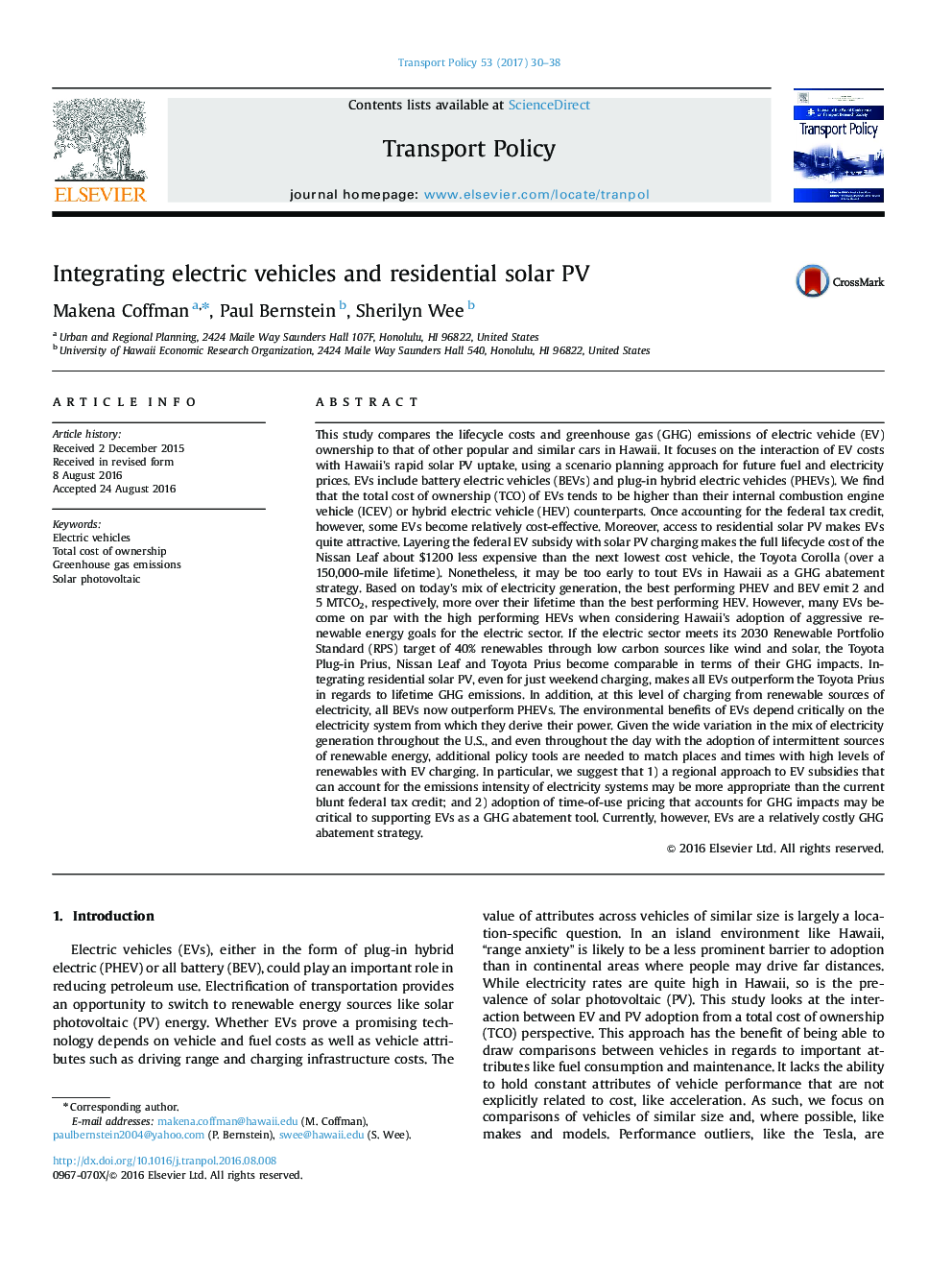| کد مقاله | کد نشریه | سال انتشار | مقاله انگلیسی | نسخه تمام متن |
|---|---|---|---|---|
| 7497302 | 1485824 | 2017 | 9 صفحه PDF | دانلود رایگان |
عنوان انگلیسی مقاله ISI
Integrating electric vehicles and residential solar PV
دانلود مقاله + سفارش ترجمه
دانلود مقاله ISI انگلیسی
رایگان برای ایرانیان
کلمات کلیدی
موضوعات مرتبط
علوم انسانی و اجتماعی
علوم اجتماعی
جغرافیا، برنامه ریزی و توسعه
پیش نمایش صفحه اول مقاله

چکیده انگلیسی
This study compares the lifecycle costs and greenhouse gas (GHG) emissions of electric vehicle (EV) ownership to that of other popular and similar cars in Hawaii. It focuses on the interaction of EV costs with Hawaii's rapid solar PV uptake, using a scenario planning approach for future fuel and electricity prices. EVs include battery electric vehicles (BEVs) and plug-in hybrid electric vehicles (PHEVs). We find that the total cost of ownership (TCO) of EVs tends to be higher than their internal combustion engine vehicle (ICEV) or hybrid electric vehicle (HEV) counterparts. Once accounting for the federal tax credit, however, some EVs become relatively cost-effective. Moreover, access to residential solar PV makes EVs quite attractive. Layering the federal EV subsidy with solar PV charging makes the full lifecycle cost of the Nissan Leaf about $1200 less expensive than the next lowest cost vehicle, the Toyota Corolla (over a 150,000-mile lifetime). Nonetheless, it may be too early to tout EVs in Hawaii as a GHG abatement strategy. Based on today's mix of electricity generation, the best performing PHEV and BEV emit 2 and 5 MTCO2, respectively, more over their lifetime than the best performing HEV. However, many EVs become on par with the high performing HEVs when considering Hawaii's adoption of aggressive renewable energy goals for the electric sector. If the electric sector meets its 2030 Renewable Portfolio Standard (RPS) target of 40% renewables through low carbon sources like wind and solar, the Toyota Plug-in Prius, Nissan Leaf and Toyota Prius become comparable in terms of their GHG impacts. Integrating residential solar PV, even for just weekend charging, makes all EVs outperform the Toyota Prius in regards to lifetime GHG emissions. In addition, at this level of charging from renewable sources of electricity, all BEVs now outperform PHEVs. The environmental benefits of EVs depend critically on the electricity system from which they derive their power. Given the wide variation in the mix of electricity generation throughout the U.S., and even throughout the day with the adoption of intermittent sources of renewable energy, additional policy tools are needed to match places and times with high levels of renewables with EV charging. In particular, we suggest that 1) a regional approach to EV subsidies that can account for the emissions intensity of electricity systems may be more appropriate than the current blunt federal tax credit; and 2) adoption of time-of-use pricing that accounts for GHG impacts may be critical to supporting EVs as a GHG abatement tool. Currently, however, EVs are a relatively costly GHG abatement strategy.
ناشر
Database: Elsevier - ScienceDirect (ساینس دایرکت)
Journal: Transport Policy - Volume 53, January 2017, Pages 30-38
Journal: Transport Policy - Volume 53, January 2017, Pages 30-38
نویسندگان
Makena Coffman, Paul Bernstein, Sherilyn Wee,